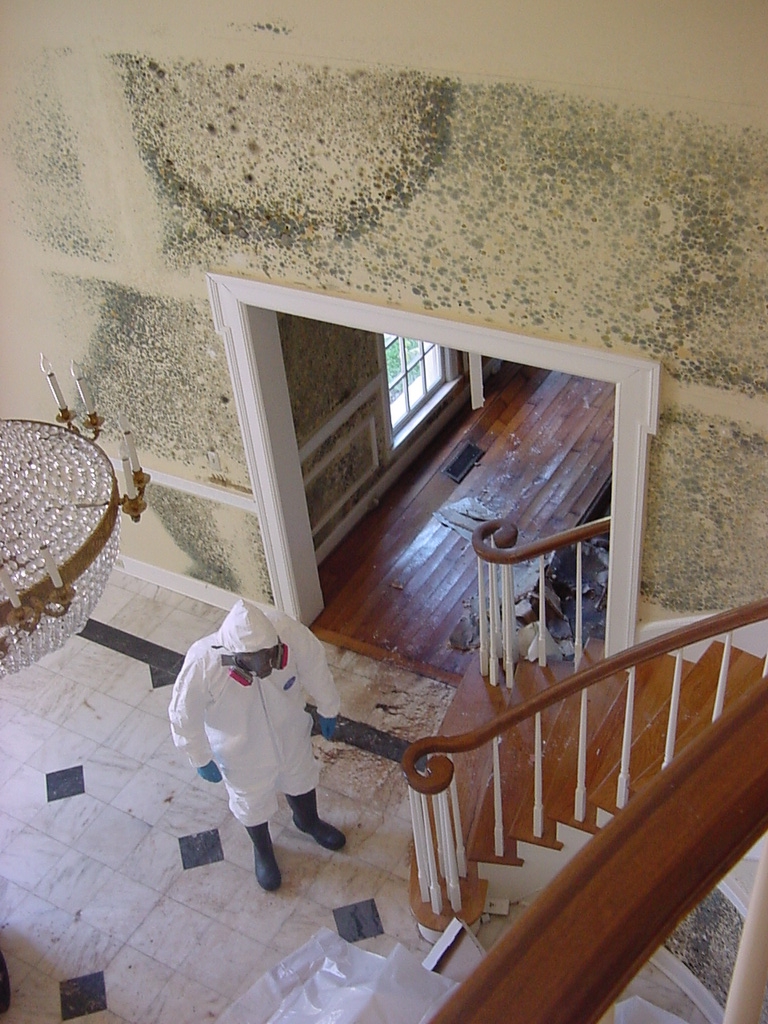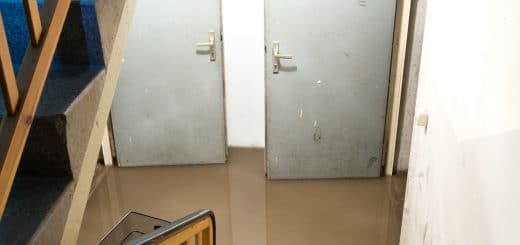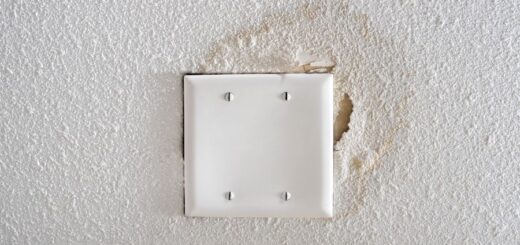How to Clean Your Washing Machine?
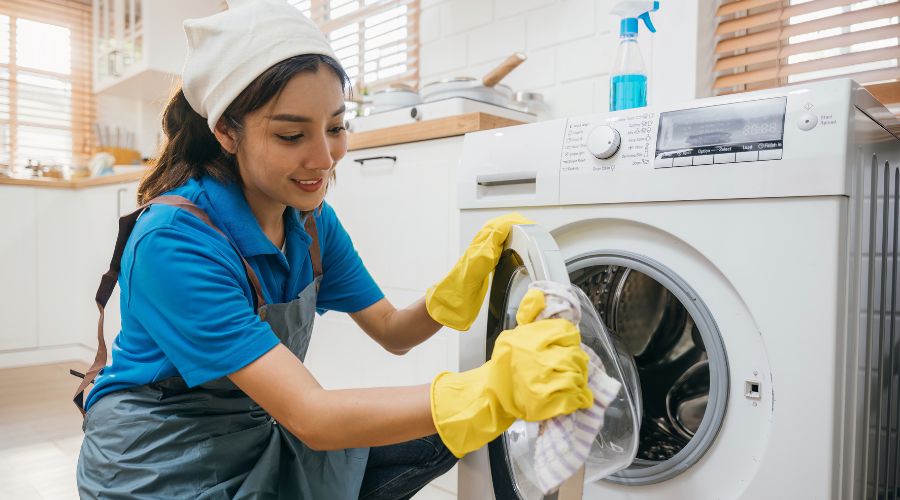
People use appliances such as dishwashers and washing machines almost every day to help with household cleaning. What may not cross the minds of many people is that these appliances also need cleaning themselves. It may seem counterintuitive to clean a machine that is used for cleaning, but regular cleaning of these appliances will help them work more effectively and last longer. Your washing machine especially should be cleaned regularly to ensure that it works its best and gives you the cleanest clothes. Another reason is that a dirty washing machine can result in faulty parts and leaks from underneath or pipes, ultimately leading to water damage.
Why Should I Clean My Washing Machine?
Washing machines are used to clean dirty clothes, towels, and bed sheets and the sweat, dirt, and grime from washing these materials can build up within the machine. Fibers, soap residueResidue is any leftover material, such as soot, dust, or che... More, and chemicals from the detergent and fabric softener can also build up within the machine and create a film that traps bacteria and odors. The heat and moisture within the washing machine creates the optimal conditions for moldMold is a type of fungus that grows in damp or humid conditi... More, mildewMildew is a type of fungus that grows on damp surfaces, typi... More, and bacteria to grow, and the built-up bacteria and odors can affect your clothes.
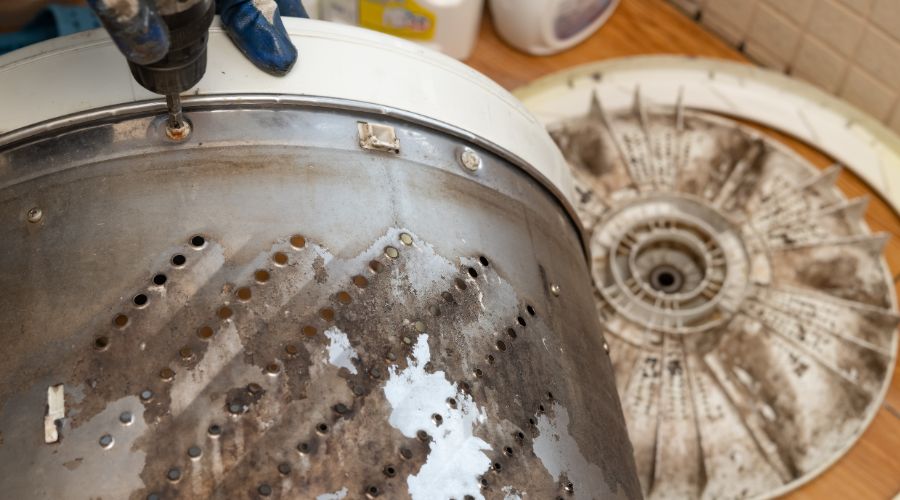
The other problem with built up dirt and grime is that it can clog the inner mechanisms and drain, causing the washing machine to work less efficiently or leak. This can also result in a shorter lifespan for your washer. To ensure that your washing machine is clean and working efficiently, you should clean your washing machine inside and out once a month.
Should I Use Vinegar or Bleach in the Washing Machine?
White vinegar and chlorine bleach are common household cleaners that can remove moldMold is a type of fungus that grows in damp or humid conditi... More and mildewMildew is a type of fungus that grows on damp surfaces, typi... More. Both are effective options to clean the wash tub of a washing machine but the choice of which one to use depends on the situation. White vinegar is highly effective at removing moldMold is a type of fungus that grows in damp or humid conditi... More and mildewMildew is a type of fungus that grows on damp surfaces, typi... More as well as odors, but bleach might be necessary for more extreme cases of moldMold is a type of fungus that grows in damp or humid conditi... More and bacteria. Some like to stick with white vinegar over bleach because it is less harsh. If you do use bleach, check the owner’s manual of your washing machine to make sure it is safe to use bleach. Be careful to never mix vinegar and bleach.
Clean and Sanitize the Drain
The first thing you should do when cleaning a front loading or top loading washing machine is clean and sanitize the drain. Start by turning off the washing machine and then disconnect the drain from the pipe. Place the disconnected drain in a bucket to let all the water drain out and check the inside of the drain for dirt or grime buildup. Remove excessive grime with a drain snake and soak the drain in vinegar to remove mold around the opening. You can use an old toothbrush and some baking soda to scrub off stubborn grime.
If your washing machine has a filter, clean or replace the filter after cleaning the drain. If you are not sure if your washing machine has a filter or where it is located, check the owner’s manual.
Clean the Wash Tub
For both front loading and top loading washing machines, you can clean the wash tub by first cleaning grime, mildewMildew is a type of fungus that grows on damp surfaces, typi... More, lint, and other bacteria from the tub and then running a load with a cleaning agent. To remove dirt and grime from the wash tub, put some white vinegar in a spray bottle and spray the inside of the tub. Wipe down the entire surface of the wash tub using a microfiber cloth and make sure you remove mildewMildew is a type of fungus that grows on damp surfaces, typi... More, grime, hair, lint, and other debris. For front loading machines, make sure you wipe down the rubber seal around the door.
After cleaning out the wash tub, you can do a deeper clean by running the washer with one of the following cleaning agents. These methods can be used for top loading and front-loading washing machines:
- Bleach: To use bleach, make sure your washer is empty and dry and set it to a normal setting with warm wash and rinse. Put half a cup of bleach in the detergent compartment and fill up the bleach compartment, then run the washer.
- Peroxide: Peroxide is a natural cleaner that is effective for dirt and stains without damaging the machine. Set your washer to the largest and hottest cleaning settings and put two cups of hydrogen in the tub, then start the washer.
- Vinegar and baking soda: The combination of baking soda and vinegar can remove grime, mildewMildew is a type of fungus that grows on damp surfaces, typi... More, and odors from the washing machine. Set your washer to the longest, hottest setting and add 3 or 4 cups of white vinegar as it fills with water. Stop the cycle once the washer starts agitating and let it soak for a couple minutes. Then add half a cup of baking soda, let it agitate again, and stop the cycle and let it soak for up to an hour. Then restart the cycle and let it finish.
- Tablets: Tablets are a convenient way to clean the wash tub. Set your washer to the normal cycle with the hottest setting, put one tablet in the tub, and run the cycle.
- Borax and washing powder: Borax is an anti-fungal cleaner that can also remove grease and odors and washing powder can remove stains. To use this method, follow these steps:
- For front loading washing machines, add 2 tablespoons of borax and 2 tablespoons of washing powder into the tub. For top loading washers, add half a cup of borax and half a cup of washing powders to the wash tub.
- Run the wash cycle on the hottest temperature.
- After the cycle finishes, add 2 cups of vinegar to the liquid dispenser or wash tub for front loaders and one quart of vinegar for top loaders.
- Run the washer again on a hot water cycle. For top loading machines, stop the cycle after it starts to agitate and let it sit for 30 minutes before restarting and finishing the cycle.
After this cycle completes, use a microfiber cloth to wipe residueResidue is any leftover material, such as soot, dust, or che... More and debris from the inside of the wash tub.
Clean Detergent Trays and Surfaces
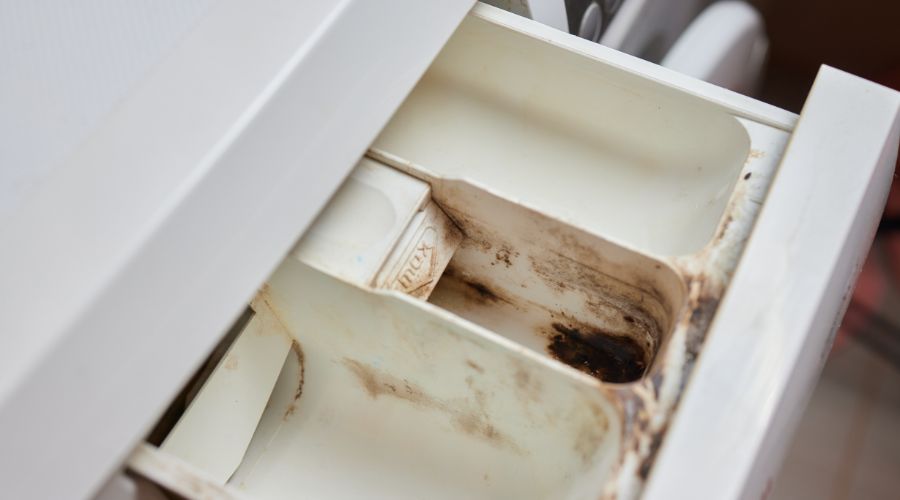
If your washing machine has detergent trays and surfaces that you fill up with detergent and fabric softener, it is important to clean these trays and surfaces. Both liquid detergents and powder detergents can cause a buildup of grime and debris such as lint and hair can also accumulate in the detergent trays and surfaces. If not cleaned, it can result into mold and mildew.
You can clean these removable parts with the following tips:
- Remove all detergent trays and surfaces from the machine.
- Soak them in hot water and remove grime and debris using a microfiber cloth or old toothbrush.
- Thoroughly rinse and dry the parts before replacing them.
Clean the Washing Machine Door or Lid
The door or lid of a washing machine can attract grime, lint, soap residueResidue is any leftover material, such as soot, dust, or che... More, and other debris that must be cleaned. You can clean the lid of top loading washing machines and the door of front-loading washing machines with these steps:
- Put a solutionA solution is a homogeneous mixture of two or more substance... More of white vinegar and water in a spray bottle. If there is excessive moldMold is a type of fungus that grows in damp or humid conditi... More or mildewMildew is a type of fungus that grows on damp surfaces, typi... More, you can use a mixture of bleach and water.
- For top loading washing machines, spray and wipe down the top and underside of the lid. Make sure you remove built-up grime and debris on the underside.
- For front-loading washing machines, make sure to thoroughly clean the door and rubber gasket that forms the seal around the door. The gasket attracts lint, hair, and other debris that should be removed.
- Use a microfiber cloth or paper towels to wipe the door or lid after applying the cleaning solutionA solution is a homogeneous mixture of two or more substance... More.
- Rinse the lid or door and wipe it dry.
How Do I Remove Odors from My Washing Machine?
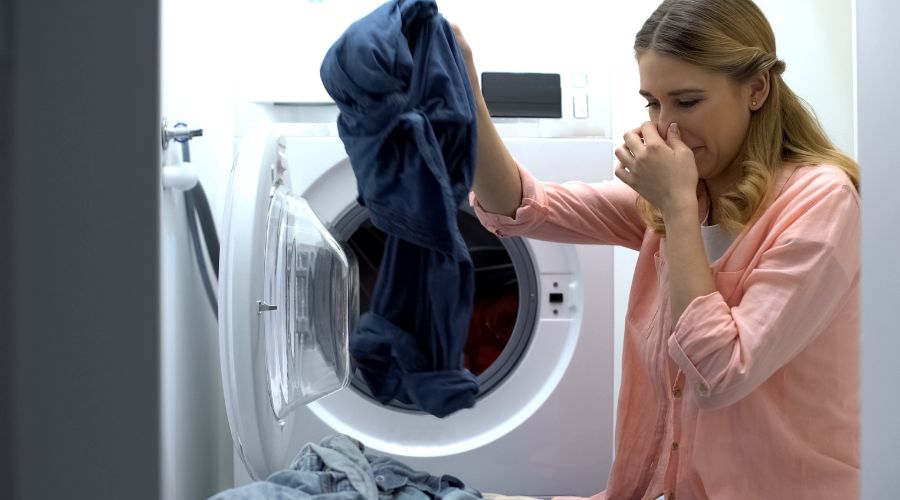
Bad odors form in washing machines due to the buildup of moldMold is a type of fungus that grows in damp or humid conditi... More, bacteria, and mildewMildew is a type of fungus that grows on damp surfaces, typi... More. The odorAn odor is a smell, often detectable by the human nose, whic... More is not only unpleasant, but it can also get onto your clothes. To get rid of these odors, spray the inside of your washing machine with white vinegar and wipe down every inch of the surface with a microfiber cloth. You can scrub the small crevices of the machine with an old toothbrush.
For front loading machines, thoroughly clean the door, including the rubber seal, to remove all grime, dirt, and debris. You should do the same for the underside of the lid for top loading machines. After cleaning, leave the door or lid open to allow the inside to air dry.
If you have particularly stubborn odors in your washing machine, you can use a cleaning tablet that removes odors. For this method, put the tablet into the washing machines and run either a regular or clean cycle. The tablet will dissolve and create suds that can remove odorAn odor is a smell, often detectable by the human nose, whic... More causing grime and mildewMildew is a type of fungus that grows on damp surfaces, typi... More from inside the machine.
How Can I Keep My Washing Machine Clean?
It is inevitable that your washing machine will need to be cleaned regularly to remove grime, mildewMildew is a type of fungus that grows on damp surfaces, typi... More, debris, and odors. However, there are steps you can take to help limit these issues, so your washing machine is not as dirty when you clean it.
- Make sure you move your laundry to the dryer as soon as it is done. Leaving your clothes in the washer after a cycle creates a warm, humid environment that can breed moldMold is a type of fungus that grows in damp or humid conditi... More and bacteria. If you do forget to move your clothing to the dryer, you should run another cycle.
- Leave the washing machine lid or door open after moving the laundry to the dryer to allow the inside of the machine to dry.
- Avoid overfilling the machine with large loads of laundry or you could overwork the washer which can cause clogs in the pipes and drain.
Water Damage Restoration from Leaking Washing Machines

Following the above-mentioned tips will help you keep your washing machine clean, which will result in cleaner clothes and a longer lifespan for your machine. Keeping the washing machine clean can also prevent clogs of the internal components of the machine, drains, and pipes that could leadLead is a heavy metal that can be toxic to humans, especiall... More to water damage. Leaks from a washing machine can cause serious damage to the surrounding areas.
If there is a leak from your washing machine that has caused damage, it is important to call a water damage restoration professional right away. Water mitigation technicians can extract the water from the leak and dry the affected flooring, drywall, and other materials. After the area and materials have been dried, these professionals will restore the resulting damage.
We were featured in a Redfin article! Check it out here: Here’s The Right Way to Clean Your Washing Machine, According To The Pros | Redfin (Parent company of ApartmentGuide and Rent.)










